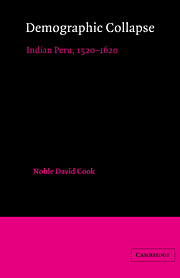Book contents
- Frontmatter
- Contents
- List of tables, figures, and maps
- Preface
- Introduction: The problem in perspective
- Part I Peru's preconquest population
- 1 The ecological approach
- 2 Population and archaeology
- 3 Depopulation ratios
- 4 Estimates from social organization
- 5 Disease mortality models
- 6 Census projections
- 7 Conclusion
- Part II Demographic collapse
- Abbreviations used in notes
- Notes
- Bibliography
- Index
- Titles in the series
3 - Depopulation ratios
Published online by Cambridge University Press: 02 December 2009
- Frontmatter
- Contents
- List of tables, figures, and maps
- Preface
- Introduction: The problem in perspective
- Part I Peru's preconquest population
- 1 The ecological approach
- 2 Population and archaeology
- 3 Depopulation ratios
- 4 Estimates from social organization
- 5 Disease mortality models
- 6 Census projections
- 7 Conclusion
- Part II Demographic collapse
- Abbreviations used in notes
- Notes
- Bibliography
- Index
- Titles in the series
Summary
Arguing by analogy with some known population (e.g. as in a model life-table) may help, assuming that the analogy is sociologically fair, but the society in question may be unique in history, and consequently not susceptible to such an analogy.
T. H. Hollingsworth, Historical Demography P. 304One of the simplest ways of estimating Peru's aboriginal population, and one that has been frequently used by scholars, is the depopulation ratio method. Use of depopulation ratios is straightforward. It does not presume an extensive knowledge of statistics.The argument is clearly understandable, and the manipulation of numbers gives an impression of scientific accuracy. The procedure is logical: Known population figures for precontact groups and later census figures for the same population unit are used to derive a ratio. The ratio is then applied to estimate the total regional population from a known census total. In this chapter we shall examine the sources, techniques, and conclusions of four recent investigators who have used depopulation ratios to estimate the Andean native population: John H. Rowe, Henry F. Dobyns, C. T. Smith, and Nathan Wachtel. John H. Rowe was one of the first modern scholars to utilize the depopulation method to calculate the aboriginal population. His estimate is based on five samples: two (Rimac and Chincha) for the coast and three (Yauyos, Huancas, and Soras) for the central highlands (see Table 4). These five cases are employed by Rowe because there are data for both the Inca period (ca. 1525) and the Toledo era (ca.1571).
- Type
- Chapter
- Information
- Demographic CollapseIndian Peru, 1520–1620, pp. 41 - 54Publisher: Cambridge University PressPrint publication year: 1982



